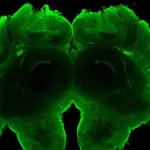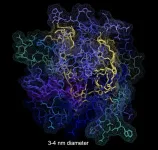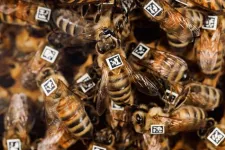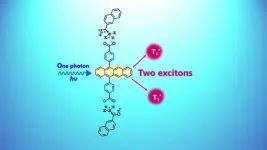(Press-News.org) KENNEDY SPACE CENTER (FL), November 1, 2024 – More than 25 payloads sponsored by the International Space Station (ISSInternational Space Station) National Laboratory, including technology demonstrations, in-space manufacturing, student experiments, and multiple projects funded by the U.S. National Science Foundation (NSF), are bound for the orbiting outpost. These investigations, launching on SpaceX’s 31st Commercial Resupply Services (CRS) mission for NASANational Aeronautics and Space Administration, aim to improve life on Earth through space-based research and foster a sustainable economy in low Earth orbit(Abbreviation: LEO) The orbit around the Earth that extends up to an altitude of 2,000 km (1,200 miles) from Earth’s surface. The International Space Station’s orbit is in LEO, at an altitude of approximately 250 miles. (LEO).
The mission is scheduled to launch no earlier than Monday, November 4 at 9:29 p.m. EST from Launch Complex 39A at NASA’s Kennedy Space Center. Below highlights some of the ISS National Lab-sponsored projects on this mission.
Bristol Myers Squibb (BMS) will build on its legacy of protein crystallization on the space station with a project, in collaboration with ISS National Lab Commercial Service ProviderImplementation Partners that own and operate commercial facilities for the support of research on the ISS or are developing future facilities. Redwire Space, seeking to crystallize model small molecule compounds to support the manufacturing of more effective therapeutics. Crystals grown in microgravityThe condition of perceived weightlessness created when an object is in free fall, for example when an object is in orbital motion. Microgravity alters many observable phenomena within the physical and life sciences, allowing scientists to study things in ways not possible on Earth. The International Space Station provides access to a persistent microgravity environment. are often larger and more well-ordered than those grown on the ground and could have improved morphology (geometric shape).
NSF is funding four investigations launching on this mission, including a collaborative project from Oregon State University and Texas Tech University focused on cardiac health. This experiment will use 3D-bioprinted cardiac organoids to study microgravity-induced heart muscle atrophy. Results could lead to an increased understanding of heart muscle atrophy, which occurs in several conditions, such as cancer, muscle disease, muscular dystrophy, diabetes, sepsis, and heart failure.
Multiple projects sponsored by the ISS National Lab and funded by NASA focus on in-space manufacturing. One investigation by Sachi Bioworks, working with ISS National Lab Commercial Service Provider Space Tango, could help advance the development of new therapeutics for neurodegenerative conditions. The project will use brain organoids in microgravity to test the effects of a novel drug on Alzheimer’s disease, Parkinson’s disease, and dementia.
The Malta College of Arts, Science, and Technology is launching a project, with support from ISS National Lab Commercial Service Provider Voyager Space, to test a heatless method of welding. Cold welding is a process that bonds similar metallic materials using force or pressure instead of heat. This method could one day be used to safely repair space platforms and ensure their long-term viability, which would help to address the growing concern of space debris. In this project, the research team will test remote-operated, cold welding to apply metal patches to simulated spacecraft hull samples.
The Student Spaceflight Experiment Program (SSEP) will send 39 student-led experiments on its 18th mission to the space station. SSEP aims to prepare the next generation of scientists and engineers by actively involving school communities in the development of scientific investigations to be conducted in microgravity. More than 35 communities took part in this SSEP mission, engaging hundreds of students in grades 5-12, junior college, and undergraduate studies.
For additional information on ISS National Lab-sponsored investigations launching on NASA’s SpaceX CRS-31, visit our launch page. To learn more about the research and technology development sponsored by the ISS National Lab, including how to propose concepts for future space-based research, visit our website.
Download a high-resolution image for this release: SpaceX CRS-27 Prepares for Launch in March 2023
END
Mission to International Space Station launches research on brain organoids, heart muscle atrophy, and cold welding
The SpaceX CRS-31 mission to the ISS for NASA includes studies on in-space manufacturing, cardiac health, and a method to repair spacecraft damaged by debris
2024-11-01
ELSE PRESS RELEASES FROM THIS DATE:
nTIDE November 2024 Jobs Report: Disability employment remains near historic highs over past 18 months
2024-11-01
East Hanover, NJ – November 1, 2024 – Following significant gains since the post-pandemic lockdown, employment rates for people with disabilities may have plateaued, remaining near historic high levels over the past 18 months despite the Federal Reserve’s efforts to slow the economy, according to today’s National Trends in Disability Employment – semi-monthly update (nTIDE) issued by Kessler Foundation and the University of New Hampshire’s Institute on Disability
Year-to-Year nTIDE Numbers (comparing October 2023 to October 2024)
The employment-to-population ratio for people with disabilities (ages 16-64) ...
Researchers aim to streamline cancer detection with new method for liquid biopsies
2024-11-01
A University of Rochester research team is reporting a new way to detect cancer cells with a “liquid biopsy” that’s designed to be simpler, faster, and more informational than current methods.
What is a liquid biopsy? It is a non-invasive test that uses blood, urine, and other bodily fluids as a vehicle for finding cancer cells or other molecules released by tumors. A liquid biopsy can detect or screen for cancer or monitor progression of the disease and how the body responds to cancer treatment.
James ...
New Huntington’s treatment prevents protein aggregation
2024-11-01
Scientists at Northwestern and Case Western Reserve universities have developed the first polymer-based therapeutic for Huntington’s disease, an incurable, debilitating illness that causes nerve cells to break down in the brain.
Patients with Huntington’s disease have a genetic mutation that triggers proteins to misfold and clump together in the brain. These clumps interfere with cell function and eventually lead to cell death. As the disease progresses, patients lose the ability to talk, walk, swallow and ...
Bee gene specifies collective behavior
2024-11-01
Embargoed: Not for Release Until 2:00 pm U.S. Eastern Time Friday, 01 November 2024.
Researchers at Heinrich Heine University Düsseldorf (HHU) are collaborating with colleagues from Frankfurt/Main, Oxford and Würzburg to investigate how the complex, cooperative behaviour of honey bees (Apis mellifera) is genetically programmed so that it can be passed on to subsequent generations. As they explain in the scientific journal Science Advances, they found an answer in what is known as the doublesex gene (dsx).
Behavioural interactions between organisms are fundamental and often inherited. ...
Jennifer Bickel, M.D., named MD Anderson Vice President and Chief Wellness Officer
2024-11-01
HOUSTON ― The University of Texas MD Anderson Cancer Center today announced the selection of Jennifer Bickel, M.D., as the institution’s inaugural vice president and chief wellness officer (CWO). She will begin on January 6, 2025. Working closely with the senior vice president of people, culture and infrastructure, as well as the chief academic officer, she will spearhead initiatives that prioritize employee well-being, professional fulfillment and community resilience.
In her new role, Bickel will implement a three-component model focusing on a culture of wellness, efficiency ...
Evolutionary paths vastly differ for birds, bats
2024-11-01
ITHACA, N.Y. – New Cornell University research has found that, unlike birds, the evolution of bats’ wings and legs is tightly coupled, which may have prevented them from filling as many ecological niches as birds.
“We initially expected to confirm that bat evolution is similar to that of birds, and that their wings and legs evolve independently of one another. The fact we found the opposite was greatly surprising,” said Andrew Orkney, postdoctoral researcher in the laboratory of Brandon Hedrick, assistant professor biomedical sciences.
Both researchers ...
Political pros no better than public in predicting which messages persuade
2024-11-01
Political campaigns spend big bucks hiring consultants to craft persuasive messaging, but a new study coauthored by Yale political scientist Joshua L. Kalla demonstrates that political professionals perform no better than laypeople in predicting which messages will sway voters.
In the study, Kalla and his coauthors evaluated how well sample groups of political practitioners — professionals who work for political campaigns, polling firms, and advocacy organizations — and members of the public could predict the effectiveness of 172 campaign messages concerning 21 political issues, including legalizing marijuana, cancelling student debt, and increasing ...
Investment in pediatric emergency care could save more than 2,100 young lives annually
2024-11-01
In emergencies, children have distinct needs because of their unique physiological, emotional and developmental characteristics. But 83% of emergency departments nationwide are not fully prepared to meet those needs — which can be life-threatening for a child in cases of severe illness or injury.
A new Oregon Health & Science University-led study, published today in JAMA Network Open, found that bridging that gap, known as becoming “pediatric ready,” could prevent the deaths of more than 2,100 children each year with modest financial investment. ...
The dynamic core of black holes
2024-11-01
Black holes continue to captivate scientists: they are purely gravitational objects, remarkably simple, yet capable of hiding mysteries that challenge our understanding of natural laws. Most observations thus far have focused on their external characteristics and surrounding environment, leaving their internal nature largely unexplored. A new study, conducted through a collaboration between the University of Southern Denmark, Charles University in Prague, Scuola Internazionale Superiore di Studi Avanzati (SISSA) in Trieste, and Victoria University of Wellington ...
Improving energy production by boosting singlet fission process
2024-11-01
Fukuoka, Japan—In organic molecules an exciton is a particle bound pair of an electron (negative charge) and its hole (positive charge). They are held together by Coulombic attraction and can move within molecular assemblies. Singlet fission (SF) is a process where an exciton is amplified, and two triplet excitons are generated from a singlet exciton. This is caused by the absorption of a single particle of light, or photon, in molecules called chromophores (molecules that absorb specific wavelengths of light). Controlling the molecular orientation and arrangement of chromophores is crucial for achieving high SF efficiency in materials with strong potential for optical ...
LAST 30 PRESS RELEASES:
Heart-brain connection: international study reveals the role of the vagus nerve in keeping the heart young
Researchers identify Rb1 as a predictive biomarker for a new therapeutic strategy in some breast cancers
Survey reveals ethical gaps slowing AI adoption in pediatric surgery
Stimulant ADHD medications work differently than thought
AI overestimates how smart people are, according to HSE economists
HSE researchers create genome-wide map of quadruplexes
Scientists boost cell "powerhouses" to burn more calories
Automatic label checking: The missing step in making reliable medical AI
Low daily alcohol intake linked to 50% heightened mouth cancer risk in India
American Meteorological Society announces Rick Spinrad as 2026 President-Elect
Biomass-based carbon capture spotlighted in newly released global climate webinar recording
Illuminating invisible nano pollutants: advanced bioimaging tracks the full journey of emerging nanoscale contaminants in living systems
How does age affect recovery from spinal cord injury?
Novel AI tool offers prognosis for patients with head and neck cancer
Fathers’ microplastic exposure tied to their children’s metabolic problems
Research validates laboratory model for studying high-grade serous ovarian cancer
SIR 2026 delivers transformative breakthroughs in minimally invasive medicine to improve patient care
Stem Cell Reports most downloaded papers of 2025 highlight the breadth and impact of stem cell research
Oxford-led study estimates NHS spends around 3% of its primary and secondary care budget on the health impacts of heat and cold in England
A researcher’s long quest leads to a smart composite breakthrough
Urban wild bees act as “microbial sensors” of city health.
New study finds where you live affects recovery after a hip fracture
Forecasting the impact of fully automated vehicle adoption on US road traffic injuries
Alcohol-related hospitalizations from 2016 to 2022
Semaglutide and hospitalizations in patients with obesity and established cardiovascular disease
Researchers ‘listen in’ to embryo-mother interactions during implantation using a culture system replicating the womb lining
How changing your diet could help save the world
How to make AI truly scalable and reliable for real-time traffic assignment?
Beyond fragmented markets: A new framework for efficient and stable ride-pooling
Can shape priors make road perception more reliable for autonomous driving?
[Press-News.org] Mission to International Space Station launches research on brain organoids, heart muscle atrophy, and cold weldingThe SpaceX CRS-31 mission to the ISS for NASA includes studies on in-space manufacturing, cardiac health, and a method to repair spacecraft damaged by debris






